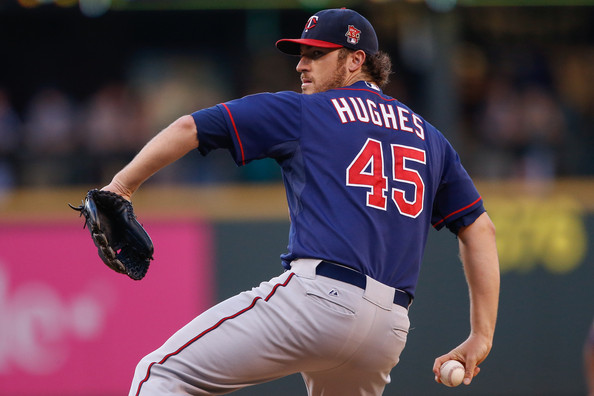August 20, 2014
Phil Hughes, Ace
Phil Hughes has been the Twins' best starter with a 3.76 ERA in 25 starts, yet that good but not great ERA vastly understates just how well he's actually pitched. He ranks 10th in the league with 140 strikeouts while issuing just 15 walks in 158 innings for a 9.3-to-1 strikeout-to-walk ratio that leads all of baseball. Clayton Kershaw ranks second behind Hughes and he's followed by Hisashi Iwakuma, David Price, Masahiro Tanaka, Felix Hernandez, and Chris Sale.
Hughes is a fly-ball pitcher and poor defense--particularly in the outfield where Josh Willingham and Oswaldo Arcia roamed the corners for most of the year alongside a revolving door of center fielders--has hurt him in the form of a .343 batting average on balls in play. Not only is that much worse than Hughes' career mark of .300, it rates as the fifth-highest batting average on balls in play across MLB among the 120 pitchers with at least 100 innings this season.
Expected Fielding Independent Pitching (xFIP) attempts to more accurately evaluate a pitcher's individual performance by removing defense, luck, and bullpen support from the mix and Hughes ranks 20th among all MLB starters in xFIP at 3.23. In other words, he's been a No. 1 starter. And he's also been much better than he ever was for the Yankees from 2007-2013, when he posted the following yearly xFIP figures as a starter:
YEAR xFIP 2007 4.58 2008 4.94 2009 4.93 2010 4.17 2011 4.74 2012 4.35 2013 4.36 ... 2014 3.23
Hughes never posted an xFIP below 4.00 as a starter with the Yankees and only once, in 2010, came within a full run of his current xFIP with the Twins. He's a completely different pitcher in a home ballpark much better suited for his skill set and the results have been dramatic. In terms of recent Twins history, Hughes is in rarefied air. Here are the best xFIP figures by Twins starters during the Ron Gardenhire era of 2002-2014:
YEAR xFIP Francisco Liriano 2006 2.54 Francisco Liriano 2010 2.95 Johan Santana 2004 3.01 Johan Santana 2005 3.12 Johan Santana 2006 3.16 PHIL HUGHES 2014 3.23
Now that's a list.
Hughes isn't throwing any harder than he did with the Yankees. His average fastball this season has clocked in at 92 miles per hour and he's used it 63 percent of the time. With the Yankees his average fastball was 92 miles per hour and he used it 63 percent of the time. His strikeout rate has improved, but only slightly from 19 percent to 21 percent, and Hughes' swinging strike rate remains at his career norm of 8.5 percent.
If he's using his fastball exactly as often and throwing his fastball exactly as hard as before and he's not missing significantly more bats, how did Hughes get so much better? Well, basically he decided to simply stop walking anyone. As a starter for the Yankees he averaged 2.8 walks per nine innings, but this season Hughes has sliced that to 0.85 walks per nine innings for baseball's second-best walk rate.
Hughes walked zero in an MLB-leading 13 of 25 starts (52 percent), whereas for the Yankees he had zero walks in 24 of 132 starts (18 percent). He also leads MLB by walking zero or one batter in 23 of 25 starts (92 percent), compared to 61 of 132 starts (46 percent) for the Yankees. His overall walk rate of 0.85 per nine innings is the second-lowest in Twins history among starters with at least 100 innings:
YEAR BB/9 Carlos Silva 2005 0.43 PHIL HUGHES 2014 0.85 Brad Radke 2005 1.03 Brad Radke 2001 1.04 Brad Radke 2004 1.07 Brad Radke 2003 1.19
And it's not just his walk rate that tells the story. According to MLB.com's Pitch-FX data Hughes has thrown a pitch in the strike zone 56 percent of the time this season, which leads all of MLB by a wide margin. In fact, among the 120 pitchers with at least 100 innings this season no one else is even above 53 percent. And as a starter with the Yankees he threw pitches in the strike zone 49 percent of the time.
No team has emphasized throwing strikes and limiting walks as much as the Twins under the duo of Gardenhire and pitching coach Rick Anderson. During their 13-season tenure together Twins pitchers have MLB's lowest walk rate at 2.6 per nine innings when none of the other 29 teams are below 3.0. Anderson's overall effectiveness has been in question for a while now, but aside from a few prominent examples he does get pitchers to throw the ball over the plate.
For many of the Twins' abundant collection of low-velocity pitchers Anderson's focus on pounding the strike zone has meant letting hitters tee off on inferior raw stuff, but in Hughes' case he's been able to maintain his above-average velocity and strikeout rate while drastically reducing his free passes. Toss in the switch from Yankee Stadium to Target Field predictably hiding his weakness for serving up homers and the result has been enough to create a 28-year-old ace.
Handing a four-year, $49 million contract to Ricky Nolasco six months ago already looks like a disaster and the Twins' other recent forays into free agent pitching to sign Kevin Correia and re-sign Mike Pelfrey for multiple years flopped as well, but Hughes' three-year, $24 million deal looks brilliant. He's on pace to throw 210 innings with the best K/BB ratio and second-best walk rate in Twins history and he's under contract for $8 million next season and $8 million in 2016.
For a lot more about Hughes' breakthrough season and change in approach, check out this week's "Gleeman and The Geek" episode with guest co-host Parker Hageman.


